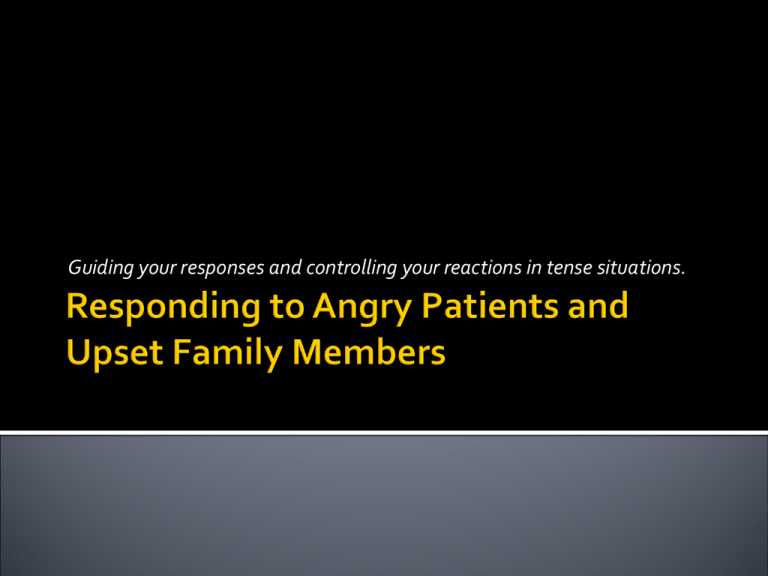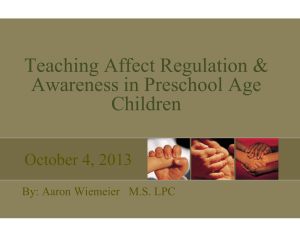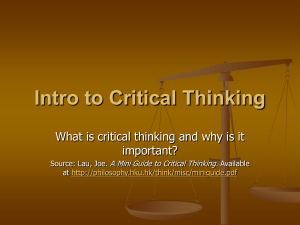Responding to Angry Patients and Upset Family Members
advertisement

Guiding your responses and controlling your reactions in tense situations. We will discuss and share examples of: 1. The advantages and limitations of this training. 2. The definitions and outcomes of anger; 3. Our reactions, both positive and negative, to anger and strong emotions and how to encourage our positive responses; 4. The stages of crisis development, what to look for and how to respond; 5. The verbal escalation continuum, what to look for and what to say; 6. Nonverbal communication and how to present ourselves in a way that will reduce emotion and encourage reasoning; and 7. Engaging in joint problem solving with the concerned parties. What this training will and won’t provide 1. 2. It promotes consistency and uniformity when working with people. This will help us be more predictable and thoughtful. It will give us some ideas and insights into why things may be happening. This will help us to prevent some problems before they occur and others from getting worse. It will also help us to feel and show empathy for the other person. 3. 4. 5. It will help us to communicate more effectively and consistently, especially during emotionally charged events. If we do this we may be able to stop a small problem from escalating into a larger one. It can enhance the delivery of services to our patients and their families. It helps us to better identify and meet their needs. It provides a structured approach to problem solving. 1. 2. 3. 4. It will not prevent/stop all incidents; It will not provide all of the answers; It will not change the people we interact with; and It will not make us experts. REMEMBER: Unfortunately, there are no guarantees when working with people. Why? Because empathy comes easier with understanding According to the Random House Dictionary of the English Language (Unabridged Edition) Anger is . . . a strong feeling of displeasure and belligerence aroused by real or supposed wrong. The clinical description of anger is much broader. It is described as a state of heightened activation or arousal of the autonomic nervous system that is fueled by our cognitive interpretations (Conscious and subconscious). We all have different things that push our buttons. What triggers your anger response? What has or would trigger your response in situations like our patients and their families face? The Angry I’s from Mark Gorkin’s The Four Faces of Anger: You have a palpable sense of: ▪ Injustice ▪ Injury ▪ Invasion ▪ Intention INJUSTICE: A rule of conduct, a cherished belief or instrumental goal is being threatened or abused; you see yourself (also others with whom you are psychologically dependent or connected) as a victim of an injustice, unfairness or disloyalty. INJURY: You feel disrespected, discarded or ignored; there's a sense of insult and humiliation along with injury - often psychological, at times also physical. INVASION: Your freedom, autonomy, boundary and personal space are perceived to be constricted, disrupted or violated; your identity and bodily and/or psychological integrity are being threatened or attacked. INTENTION: There is an energy and determination to do something about the aforementioned injustices, injuries and invasions; you are ready - reflexively and/or purposefully - to challenge the status quo. When it goes from internal to external. No, but it certainly can be. So let’s set some criteria so we can better describe it and categorize it. Mark Gorkin, in Anger or Aggression: Confronting the Passionate Edge (1986) identified these four: 1. 2. 3. 4. Purposeful Spontaneous Constructive Destructive Purposeful - When anger expression is intentional, with a significant degree of consideration or calculation; there is also a significant degree of self-control. Spontaneous - When anger expression is immediate with little contemplation or planning; there is little to moderate selfcontrol. Constructive - When anger expression affirms and acknowledges one's integrity and boundary without objectively intending to threaten or violate another's integrity or appropriate boundary. Destructive - When the expression of anger defensively projects and rigidly fortifies one's identity and boundary by threatening or violating another's integrity and appropriate boundary (Whether the intention is conscious or not). What do these criteria produce when combined? Constructive Destructive Purposeful Assertion Hostility Spontaneous Passion Rage THE LEVEL OF EMOTION As the level of emotion goes up; reasoning ability goes down and when that happens communication breaks down too. Yes But first we need to be calm and reasonable ourselves. And that’s not always easy, given our natural reactions to the strong emotions of others. So what do we do? You can’t help others if you can’t control yourself As we have already discussed when emotions are high, reasoning suffers and also, what we do can affect how it will proceed for us. Our reactions matter! This is referred to as the Reciprocal Reaction. Low High High Low It is based on the simple concept of action reaction. What you say and do affects the behavior of others and vice versa. In this application it involves consciously monitoring yourself and getting involved in order to defuse an emotional situation. How was anger expressed in your family growing up? How do you express it now? How does your experience affect how you respond to anger now? The Fight or Flight Response What is it? First described by Walter Bradford Cannon The theory states that we react to threats with a general discharge of the sympathetic nervous system, priming us for fighting or fleeing. 1. Freeze Inaction, inability to react to a situation. Example: Stage fright 2. Overreact Rationally – Misperceive situation, make it worse than it really is. Sensorimotor – Motor skills don’t function normally. 3. Inappropriate Response Verbally – Saying things that are not pertinent to the circumstances, not helpful, or even damaging to the situation. Physically – Slamming, shoving, throwing something intentionally or unintentionally. 1. Increase in Sensory Acuity Special alertness or sharpening of your senses takes place. 2. Decrease in Reaction Time We respond more quickly to circumstances than normally. 3. Increase in Speed and Strength Hormones released into our bloodstream increase these abilities. 1. Understand what about these situations makes us fearful or anxious. 2. Learn what to do when such situations arise. 3. Use a team approach. Not being the only one in the situation helps. 4. Know what to do in case of an emergency. Staying cool and calm is important and we need to find techniques that work for us. Some of these techniques are: Count to ten; Don’t personalize the person’s reaction; Controlled breathing; Positive self-talk (I am O.K., I can do this); Empathize – Walk in their shoes; Here them out, really listen; or Realize that the only person you can truly control is you. What to look for and how to respond to them 1 2 3 Due to the nature of these situations, it is vital that you stay calm and proceed with a plan. This information will help you to respond appropriately to the individual given their current emotional state. Even more important is the fact that crisis moments don’t just sprout into being; there are almost always warning signs that let you know an individual’s behavior is escalating. The earlier you intervene the better. Crisis Stages 4 1. Anxiety 3 2 4. Tension Reduction Crisis Development 2. Defensive 1 0 1. Anxiety 3. Acting Out 2. Defensive 3. Acting Out 4. Tension Reduction Anxiety: An observable and unusual change in behavior. This may mean an increase or a decrease in activity. In your setting, what would you look for? Your Response: Be empathetic; convey to the individual that you know he or she is anxious and that you would like to help alleviate it. What might you say? Defensive: His or her emotional level is increasing and rationality is decreasing. He or she may begin challenging you or the authority you represent and become belligerent. There are verbal and nonverbal cues that he/she is losing control. What are they? Your Response: Provide guidance, be directive. Take control of the escalating situation and set limits. Focus on what you can do and what they should do. What might you say? Acting Out: The person has lost control of his/her behavior and can be verbal and/or physically acting out. Not usually capable of reasoning at this point. Your Response: Make sure that you and those around you are safe and activate your emergency procedures as directed for your location. Request assistance as needed. Tension Reduction: After an episode subsides. The emotion fades, the individual regains rationality and in many cases realizes he or she has done something inappropriate. Your Response: Reconnection and problem solving. Communicate with the person as they calm down. They look to “make amends” this affords an opportunity to effect positive growth. What might you say here? What to look for and what to say Now we will dig deeper and look specifically at verbal escalation as it begins in stage 2. This is the crisis level we are usually confronted with on the job. We’ll explore the action reaction steps so we can respond more quickly, effectively, and hopefully, move things towards a positive outcome. Questioning: Information Seeking – A rational question seeking a rational response. Question Authority – Power struggle – evasiveness. Intervention: Rational response Stay on topic ,focus on the issue at hand and what can be done about it. How would you say it? Refusal: Non-compliance. Slight loss of rationalization. Intervention: Set Limits (simple negotiations) If you do this, this can happen If not, then this will happen. Release: Acting out, emotional outburst, loss of rationality. Venting, screaming, swearing. High energy output, no focus. Intervention: If possible, allow the person to vent. Remove audience or individual from area. When individual starts to quiet, state directives that are nonthreatening. Tone should be one of understanding and reason. Be ready to enforce any limits you impose. Making sure that the message you’re sending is the message they’re receiving! We will define what communication is and discuss its components; Discuss why nonverbal communication is a critical consideration when communicating; Identify how to use nonverbal methods to help communicate more effectively with persons in emotional situations; and Review and apply those nonverbal techniques. How would you define it? Communication is a two or more way, dynamic, interactive process of information exchange. It is multi-level. The more levels used, the more likely the information is to be received/understood as sent. 7% of message pertaining to feelings and attitudes is in the words that are spoken. 38% of message pertaining to feelings and attitudes is paralinguistic (the way that the words are said). 55% of message pertaining to feelings and attitudes is in facial expression. Albert Mehrabian, PhD: Professor Emeritus of Psychology, UCLA 7% 55% 38% Spoken Words Paralinguistic Facial Expression & Body Language 15% of feelings and attitudes is in the words that are spoken. 85% of feelings and attitudes is paralinguistic (the way that the words are said). (From 38% 85%). 0% of feelings and attitudes is in facial expression (From 55% 0%). Deborah Edwards, PhD, Office of Information Technologies, University of Mass. 0% 15% 85% Spoken Words Paralinguistic Facial Expression & Body Language Considering this, just imagine the challenges we face with email! Once we have figured out the words we need to say, just saying them isn’t enough. If our body and/or voice is sending a different message it can confuse or even contradict what we are trying to communicate. Body language can also effect emotion. As a wise friend of mine once said, “It doesn’t matter what you said, it’s what they heard.” There are three components to consider in nonverbal communication when addressing an emotional situation: Personal Space Body Posture and Movement Para-verbal Communication Let’s examine the following nonverbal behaviors to determine: 1. Is the person’s response to the interaction learned or instinctive (Why is that important?) 2. Does the action likely increase emotion/anxiety or promote reasoning/allow and encourage the person to be calm? Close (< 18”) Normal (18” – 36”) Far (> 36”) X X X Action Learned Response Instinctive Response Side X Front X Rear X Increases Emotion Promotes Reasoning Action Learned Response Instinctive Response Above X Level/Equal X Below* X Increases Emotion Promotes Reasoning Action Learned Response Instinctive Response No Eye Contact X Staring X Neutral/Blinking X Increases Emotion Promotes Reasoning Action Learned Response Instinctive Response More/Bigger X Less/Smaller X Increases Emotion Promotes Reasoning Action Learned Response Apathetic/Sleepy X Alert/Engaged X Jumpy/Anxious Instinctive Response X Increases Emotion Promotes Reasoning Action Learned Response Slouching/Leaning Away X Relaxed, but Attentive X Appear Rigid or Stiff Instinctive Response X Increases Emotion Promotes Reasoning Action Learned Response Instinctive Response Volume – Loud X Volume - Moderate X Volume – Soft* X Increases Emotion Promotes Reasoning Action Learned Response Instinctive Response Tone – High Pitch X Tone – Moderate Pitch X Tone – Low Pitch X Increases Emotion Promotes Reasoning Action Learned Response Instinctive Response Sharp/Halting X Flowing X Increases Emotion Promotes Reasoning Action Learned Response Instinctive Response Slow X Moderate X Fast X Increases Emotion Promotes Reasoning What is the most “non-threatening” approach? 1. 2. 3. 4. 5. Personal Space Body Juxtaposition Height Relationship Eye Contact Gestures 6. 7. 8. Energy Level Posture Para-verbal Communication a.Volume b.Pitch c.Inflection d.Rate of Speech Reviewing the key concepts presented As was said before, due to the nature of these situations it is vital that you stay calm and proceed with a plan. Crisis moments don’t just happen; there are almost always warning signs that provide an opportunity to intervene before a crisis occurs. By following these tips, you can often intervene before the crisis becomes problematic. 1. BE AWARE: Remember the signs to watch out for when someone is becoming anxious or otherwise more emotional such as: ▪ An observable and unusual change or increase in behavior; or ▪ He or she may begin challenging you or the authority you represent and become belligerent. 2. BE EMPATHETIC: Try not to judge or discount the feelings of others. Whether or not you think their feelings are justified, those feelings are real to the other person. Pay attention to them. 3. CLARIFY MESSAGES: Listen for the person’s real message. What are the feelings behind the facts? Ask reflective questions and use both silence and restatements. 4. RESPECT PERSONAL SPACE: Stand at least 1.5 to 3 feet from an acting-out person. Invading personal space tends to increase the individual’s anxiety and may lead to acting-out behavior. 5. BE AWARE OF YOUR BODY POSITION: Standing eye-to-eye and toe-to-toe with a person sends a challenging message. Standing about 3’ away and at an angle off to the side is less likely to escalate the individual. 6. IGNORE CHALLENGING QUESTIONS: When a person challenges your authority or a facility policy, redirect the individual’s attention to the issue at hand. Answering challenging questions often results in a power struggle. Power struggles are a “Lose – Lose” 7. PERMIT VERBAL VENTING WHEN POSSIBLE: Allow the individual to release as much energy as possible by venting verbally. If you cannot allow this, state directives and reasonable limits during lulls in the venting process. 8. SET AND ENFORCE REASONABLE LIMITS: If the person becomes belligerent, defensive, or disruptive, state limits and directives clearly and concisely. When setting limits, offer choices and consequences to the acting-out individual. Of course never promise any consequence you can’t deliver on. 9. KEEP YOUR NONVERBAL CUES NONTHREATENING: The more an individual loses control, the less that individual listens to your actual words. More attention is paid to your nonverbal communication. Be aware of your gestures, facial expressions, movements, and tone of voice. 10. AVOID OVERREACTING: Remain calm, rational, and professional. Your response will directly affect the person’s behavior. 11. ASSUME THE PATIENT/ FAMILY MEMBER HAS A RIGHT TO BE ANGRY: Don’t use statements that minimize their problems or their feelings. “Apologize” and focus on what you can do for them, not what you can’t do. Now that things have calmed down, where do we go from here? Consider the Cost of an Upset “Customer” 1. Average business doesn’t hear from 96% of unhappy customers. 2. For every one complaint received, there are 24 people with unvoiced problems, six of which are serious. 3. >= 90% who are dissatisfied with the service they receive will not come back. 4. Of those who complain, 50% - 70% will do business again if complaint is resolved. 95% will return if resolved quickly. 5. Average customer with a complaint tells 9 to 10 people, 13% tell more than 20 people. 6. Those who have complained and had resolution tell five people. Let’s take a moment to address the single most popular false idea about customer service. It’s a great slogan, credited to H. Gordon Selfridge, “ The customer is always right.” Unfortunately, it’s wrong and misleading. Clearly, they are not always right. They may make unreasonable requests; Have unreasonable expectations; Perhaps even play fast and loose with the truth; and They may not even understand how your services operate and what you can and can’t do for them. Practically speaking, you can’t operate under the assumption that the customer is always right because you are not able to give every customer what he or she wants. Here are two short phrases that set the tone for how should we treat our patients and family members. 1. The patient/family member always deserves to be treated as if he or she is important and his or her opinions, needs, and wants are worth your attention. 2. The patient/family member deserves to receive the maximum effort of those serving him or her, even when his or her expectations, wants, and needs may be impractical. The implications for customer service are simple: 1. The individual has other important wants and needs besides what was requested that you likely can meet; 2. Even where you can’t do what the individual asks, you can contribute to the individual’s positive impression about how he or she is treated; 3. We focus not only on what we provide, but on how we provide it. That’s the key to realistic and excellent service. Now let’s get on with the problem solving. 1. Listen actively and confirm your understanding of the problem expressed. 2. Problem solve together, find any solution that can work for the individual and the organization. 3. Discuss possible options and offer a choice if at all possible. 3. Research and/or Reach Out; don’t rely solely on what you already know. There may be additional options or supports available. 4. Resolve the situation if you can. If not, try to bring in someone who can. In so far as it is up to you, always keep the discussion POSITIVE! Always tell the person what you can do, not what you can’t do. Use positive statements and keep your voice and body language neutral/positive. If you cannot do what the individual is asking, first apologize and then explain why. If at all possible, offer an alternative if you cannot meet their original need. You will need to determine who is best suited to address the patient’s questions and concerns and hand them off if necessary. For example, someone with particular expertise or authority such as your manager could be contacted/brought in. Some problems will result in complaints, which generally must be handled in accordance with policies and procedures. But often times we have the chance to fix the problems or suggest a solution before it escalates further. Remember, the earlier we intervene, the less upset the patient will likely be. What questions, concerns, or situations would you like to discuss?







